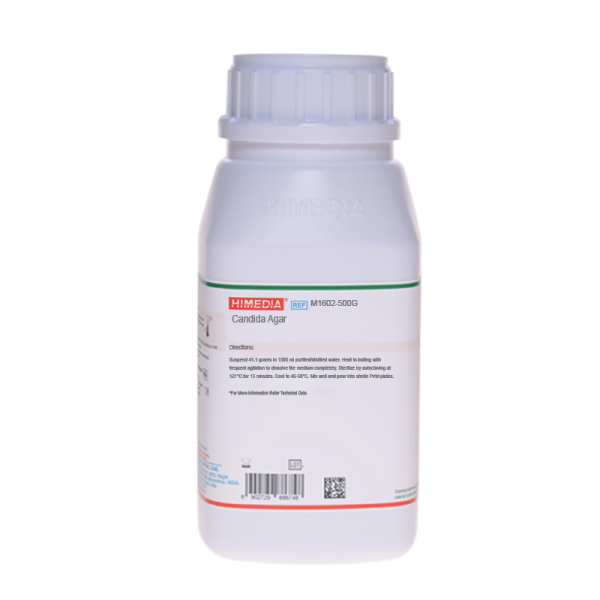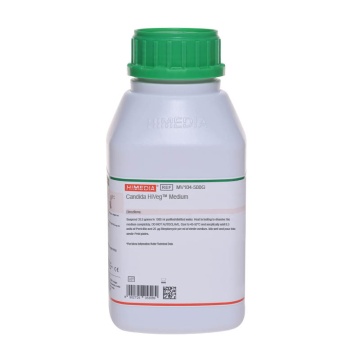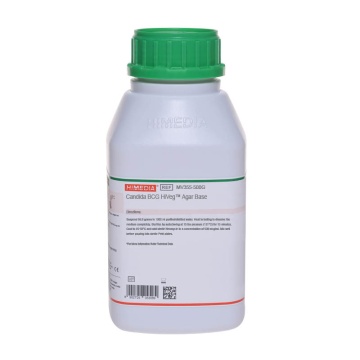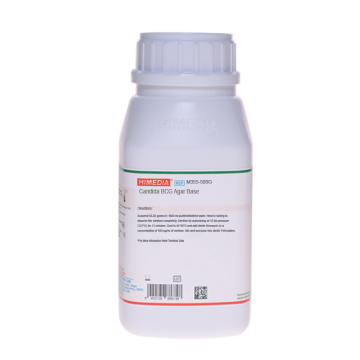 Your enquiry has been submitted
Your enquiry has been submitted
Candida Agar
Intended Use
Recommended for isolation and differentiation of Candida albicans.
Composition**
| Ingredients | g / L |
|---|---|
| Yeast extract | 3.000 |
| Malt extract | 3.000 |
| Peptone | 5.000 |
| Dextrose (Glucose) | 10.000 |
| Aniline blue | 0.100 |
| Agar | 20.000 |
Final pH ( at 25°C) 6.2±0.2
**Formula adjusted, standardized to suit performance parameters
Directions
Suspend 41.1 grams in 1000 ml purified/distilled water. Heat to boiling with frequent agitation to dissolve the medium completely. Sterilize by autoclaving at 121°C for 15 minutes. Cool to 45-50°C. Mix well and pour into sterile Petri plates.
Principle And Interpretation
Candidiasis is an acute or sub-acute infection caused by members of the genus Candida, mainly Candida albicans, although all species may be pathogenic. C.albicans produce lesions in the mouth, oesophagus, genitourinary tract, skin, nails, bronchi, lungs and other organs in patients whose normal defense mechanism may have been altered by underlying disease, antimicrobial therapy or immunosuppressive agents (1). Since saprophytic yeast are microscopically similar to the pathogenic species, all infected material should be cultured on duplicate sets of media with and without antifungal agents.
Candida Agar was developed as described by Fung and Liang (2), which is a modification of Yeast and Mould Agar. It is a nutritionally rich medium, which supports the growth of many yeasts and moulds and is differential for C. albicans. Goldschmidt demonstrated that YM agar with aniline blue could be used to identify C. albicans with high accuracy and predictability (3). Aniline blue is a fluorescent indicator, metabolized by C. albicans to produce a fluorescent moiety that can be easily detected under UV light.
Peptone, yeast extract and malt extract in the medium provide nitrogen, carbon, vitamins, and other essential nutrients required for the growth of C. albicans. Dextrose is an energy source. Aniline blue is a fluorescent indicator. Some strains of C. parapsilosis, C. krusei and C. pulcherrima may give slight fluorescence and that may be distinguished from C. albicans by germ tube formation (3,4). Specimen is processed and inoculated directly onto the surface of the media.
Type of specimen
Clinical samples - blood sample or scraping from the infected body site.
Specimen Collection and Handling
For clinical samples follow appropriate techniques for handling specimens as per established guidelines (4,5).
After use, contaminated materials must be sterilized by autoclaving before discarding.
Warning and Precautions
In Vitro diagnostic Use only. For professional use only. Read the label before opening the container. Wear protective gloves/protective clothing/eye protection/ face protection. Follow good microbiological lab practices while handling specimens and culture. Standard precautions as per established guidelines should be followed while handling clinical specimens. Safety guidelines may be referred in individual safety data sheets.
Limitations
- Individual organisms differ in their growth requirement and may show variable growth patterns on the medium.
- Further biochemical and serological tests must be carried out for further identification.
Performance and Evaluation
Performance of the medium is expected when used as per the direction on the label within the expiry period when stored at recommended temperature.
Quality Control
Appearance: Light yellow to pink homogeneous free flowing powder
Gelling: Firm,comparable with 2.0% Agar gel
Colour and Clarity of prepared medium: Bluish green coloured, clear to slightly opalescent gel forms in Petri plates
Reaction: Reaction of 4.11% w/v aqueous solution at 25°C. pH : 6.2±0.2
pH: 6.00-6.40
Cultural Response
Cultural characteristics observed after an incubation at 25-30°C for 24-48 hours.
| Organism | Inoculum (CFU) | Growth | Recovery | Fluorescence |
|---|---|---|---|---|
| ** Bacillus spizizenii ATCC 6633 (00003*) | 50-100 | good-luxuriant | >=70% | negative reaction, no fluorescence |
| Candida albicans ATCC 10231 (00054*) | 50-100 | good-luxuriant | >=70% | positive reaction, yellow-green fluorescence |
| Candida krusei ATCC 24408 | 50-100 | good-luxuriant | >=70% | variable reaction |
| Candida tropicalis ATCC 1369 | 50-100 | good-luxuriant | >=70% | variable reaction |
| Escherichia coli ATCC 8739 (00012*) | 50-100 | luxuriant | >=70% | negative reaction |
Key : *Corresponding WDCM numbers. **Formerly known as Bacillus subtilis subsp. spizizenii
Storage and Shelf Life
Store between 10-30°C in a tightly closed container and the prepared medium at 20-30°C. Use before expiry date on the label. On opening, product should be properly stored dry, after tightly capping the bottle in order to prevent lump formation due to the hygroscopic nature of the product. Improper storage of the product may lead to lump formation. Store in dry ventilated area protected from extremes of temperature and sources of ignition. Seal the container tightly after use. Product performance is best if used within stated expiry period.
Disposal
User must ensure safe disposal by autoclaving and/or incineration of used or unusable preparations of this product. Follow established laboratory procedures in disposing of infectious materials and material that comes into contact with clinical sample must be decontaminated and disposed of in accordance with current laboratory techniques (4,5).
Reference
- Utz J. P., 1967, Med. Clin. North Am. 51:519-527
- Fung and Liang, 1988, Bull Inf. Lab. Serv. Vet (France), 39/30:1
- Goldschmidt, Fung, Grant White and Brown, 1991, J. Clin. Microbiol., 29:1095.
- Jorgensen, J.H., Pfaller, M.A., Carroll, K.C., Funke, G., Landry, M.L., Richter, S.S and Warnock., D.W. (2015) Manual of Clinical Microbiology, 11th Edition. Vol. 1.
- Isenberg, H.D. Clinical Microbiology Procedures Handbook 2nd Edition.
| Product Name | Candida Agar |
|---|---|
| SKU | M1602 |
| Product Type | Regular |
| Physical Form | Powder |
| Origin | Animal |
| Packaging type | HDPE |
| References | 1. Utz J. P., 1967, Med. Clin. North Am. 51:519-527 |
| Customized Product Available | No |











